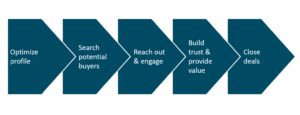Welcome to 2024, where traditional ‘selling’ is no longer the done thing. The art of the selling has moved on from an obsession with always closing a deal, or ruthlessly pushing products or services on reluctant customers.
Instead, companies build connections, nurture relationships, and offer potential customers a solution to their problem. So why is this kind of social selling such a hit? Because it doesn’t feel like selling.
Here’s a short introduction to what social selling actually is, how it works, and most importantly, how you can get started with it today.
What is social selling and why does it work?
Social selling is very much about ‘reaping what you sow’. It’s a process that focuses primarily on forming relationships online so that you can eventually offer a solution to a potential customer. As social media expert Gary Vaynerchuk says: “Jab, jab, jab, right hook”!
To break down the approach: you build your relationships by showing your expertise, keeping a conversation alive, and showing your interest in the potential customer (i.e. jab, jab, jab) and when your potential customer reveals their problem, you can ‘hit’ them with your solution (i.e. your right hook).
Social selling is about building trust, establishing relationships and offering real help where needed. And all this through various online channels. Ready to stop selling and make more sales?
Why you should have started with social selling yesterday
Some quick facts:
- Social sellers gain a 57% higher return on investment from social selling compared to a 23% return using traditional sales tactics
- 80% of B2B leads come from LinkedIn
So what’s the secret to social selling, and how can you get on board? Well, the process looks like this:

Let’s have a look at how, in just 5 steps, you could be closing deals by truly meeting the needs of customers who don’t even feel like they’ve been ‘sold to’.
1. Optimise your LinkedIn profile
If you want to appear trustworthy, you need to have a LinkedIn profile that looks and acts the part. The ultimate profile on LinkedIn gets each of the following items just right:
A good profile picture
It’s not easy to get the perfect headshot, but it’s worth making the effort. First of all, take a picture from your shoulders up. That way, potential customers will easily recognise you and will feel that they are making a connection with you as a person, rather than with whatever you’re selling.
Make sure you don’t have a distracting background, to keep the focus on you. And last but not least: choose the photo carefully. Maybe the photo of you at the bar is better for Facebook than LinkedIn – it’s great to show your true self, but you can do this with a smile rather than a glass of wine.
A relevant background banner
Your LinkedIn background banner is the ideal place to show your personality, brand and/or company. If you’re lacking inspiration, ask your company to provide you and your colleagues with a background picture. This increases brand recognition and can help demonstrate the expertise of the company.
Not working for a company? Choose an image and an inspirational quote that fit your personality, and give it your own look. You can use the app Canva to create a personalised LinkedIn banner adapted to your style.
A catchy headline
Although many people think you should mention your current job in your headline (even LinkedIn suggests it), there are more important things to mention here that can really grab a reader’s attention.
First of all, highlight an important attribute you have, such as, you can solve any marketing problem, you’re always there to help companies reach their goals, you help a company grow etc.
Then, explain the value you bring with important keywords and skills. These are not only important to show your expertise, but also to let potential customers find you when they’re looking for a solution.
Lastly, you can mention your current position or add a call to action to boost your connection potential.
A summary
Although this section is supposed to be a summary, you don’t have to be brief. Use it to include everything that potential customers might be looking for.
How do you write your summary? Try to start with a hook, a real summary of who you are, what you have already achieved and what you are doing right now. After your hook, give some benefits your company brings and explain what services you offer.
Do you have some social proof, testimonials or interesting facts? Put them here! Don’t forget to add a call to action and add some rich media, like a short video, to show off your expertise.
Your experience
Give potential connections an insight into your expertise with a brief overview of what you have done previously and what you are doing now. Include a short introduction to the company you are working/worked for and try to describe what you bring/brought to the company.
Write about what you accomplished, not what you did. You can add an extra call to action to encourage your potential customer to connect.
Your education
Add your education and qualifications, but don’t forget about relevant courses and extracurricular activities. If you have any media to add, don’t hesitate! This will help prove that you know what you’re talking about and that you have valuable skills that you can already apply to real-life problems.
Your skills and endorsements
Add your skills to your LinkedIn profile and ask for people who worked with you (e.g. colleagues, managers, clients, etc.) to endorse you.
This word-of-mouth technique is well known and a really quick win for gaining trust and showing expertise.
Your accomplishments
Apart from your education, add any projects and/or courses that you have finished, languages you speak, articles you published and any awards or recognition you received.
And last, but definitely not least: your contact information
This one hardly needs explanation, but it’s worth stressing anyway: if you hope to attract people and inspire them to connect with you, they need to know how to reach you. So make sure your information is accurate and correct.
2. Search for potential buyers
Now that your LinkedIn profile is ready to go, it’s time to make connections! However, Linkedin has millions of profiles and not all of them are worth connecting with. So how do you find the perfect connection?
First of all, it’s important to try to understand you who your target audience is. If you haven’t done so already, create personas. They help you identify the values, motivations, needs, wishes, frustrations, and dreams of your ideal customers, and help you better understand the criteria they use to make a decision.
When you’re ready to start searching, you can use Boolean strings to find connections that correspond to your what you have to offer. For example, the following Boolean strings are worth remembering:
- Quotation marks are used for exact phrases (i.e. phrases of two or more words)
- Parentheses (brackets) are used for complex searches
- NOT searches are used to exclude search results
- AND searches generate all searches in a list
- OR searches broaden up your search
Now that you have found your perfect new match, you need to connect.
But wait! Don’t just hit the ‘Connect’ button just yet. Think about how to make your connection request as irresistible as possible.
Check if you have any mutual interests and ‘like’ some of their posts (or even better, ‘wow’ them). When you know what you want to say, draft a nice message, ask an interesting question, and tell your possible new connection how you heard about him.
Remember that you sowing the seed to develop a relationship, not ‘sell’. So don’t talk about your products or services, or suggest an appointment.
3. Reach out and engage
You have a new connection, but the social selling process doesn’t end here. Try to engage with them by keeping the conversation alive.
Ask relevant questions, and talk about mutual interests. Always show empathy and let the new connection know that you care and are interested in their opinion.
As well as maintaining a conversation, nurture the relationship by ‘liking’ and engaging with their posts, and relaying your comments to the person themselves.
4. Build trust and provide value
This step is important for both your connections and yourself: provide value by posting interesting content. This way you show your expertise while at the same time, invest in long-term relationships.
If you have valuable content, don’t hesitate to share it directly with your connections by sending them a personal message. This can bring even more open discussions and is a way to keep those conversations alive and relevant.
5. Close deals
Of course social selling isn’t social selling without actually closing a deal, or securing an appointment.
By posting valuable content, you show your expertise; by giving them a full profile of your past and present activities, you show them your experience; by keeping the conversation alive, you show your interest in this person.
Social selling isn’t about closing a deal right away. It’s like farming: planning your course of action, preparing your ‘tools’, sowing the ‘seeds’, ongoing maintenance, and then harvesting!
When your potential customer is ready for your solution – because he or she experiences the problem you solve – you are right there, ready to help.
And you already offer more than any other competitor thanks to all the expertise you have been showing, because you have built up an almost personal connection, and because you were always there to help. So why wouldn’t they choose you!
For other Digital marketing topics, take a look at our Digital Marketing Guide.


